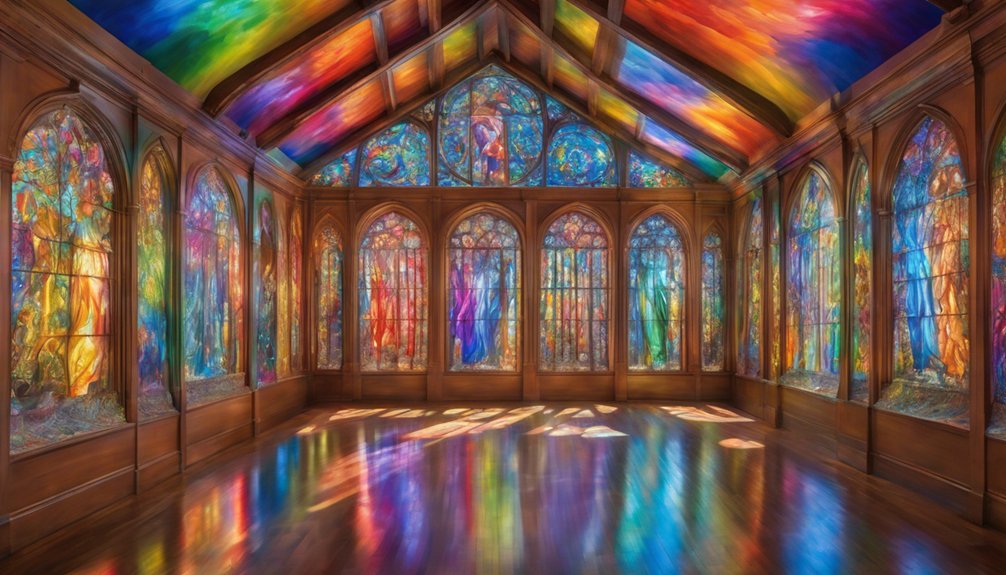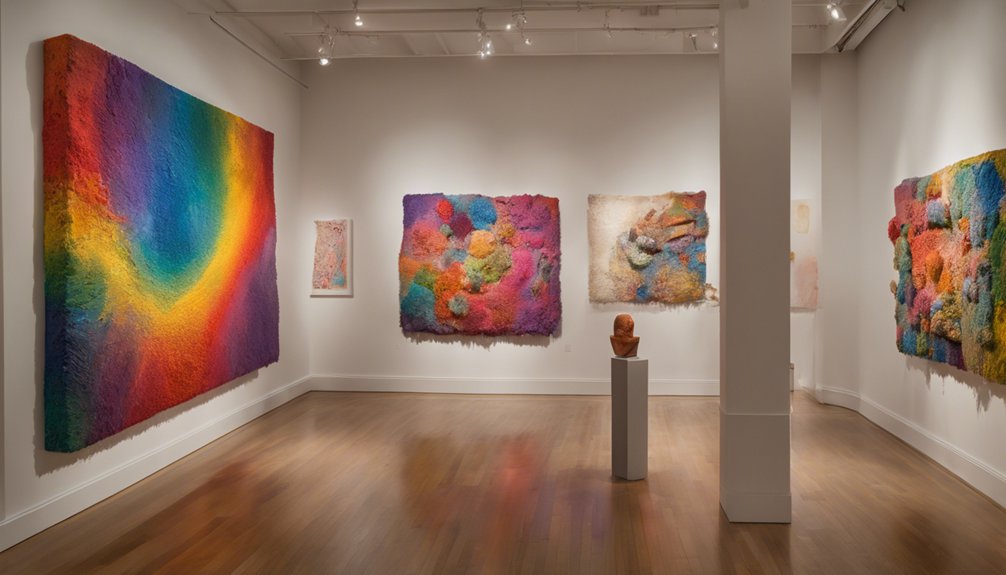The Queer Lens: Unveiling Secret Messages in LGBTQ+ Art


Table of Contents
ToggleImagine stepping into a colorful tapestry where every thread whispers secrets of resilience and identity. You start to see how LGBTQ+ artists use symbols like the pink triangle and green carnation to speak volumes about their odysseys. These symbols aren’t just art; they’re hidden messages, a language of defiance and belonging. Have you ever wondered how these secret codes continue to shape and challenge societal norms today? As you investigate this vibrant world, you’ll uncover stories that aren’t always visible at initial glance, revealing the powerful narratives woven into every piece.
Symbolism plays a powerful role in LGBTQ+ art, offering a secret language that communicates identity and resistance. When you look at the green carnation, you’re seeing a symbol Oscar Wilde popularized in the late 19th century. It was a subtle way for LGBTQ+ individuals to express themselves and find others like them. Another powerful symbol is the pink triangle, which started as a mark of oppression during the Nazi regime but was reclaimed as a proud emblem of resilience and defiance.
If you plunge into the 1970s San Francisco scene, you’ll find the handkerchief code. By choosing specific colors, you could discreetly communicate your sexual interests within the queer community. It’s a creative form of expression that used everyday items for deeper connections.
Polari, a secret slang with around 500-600 words, was another tool for communication among gay men from the 1930s to the 1960s. It allowed conversations about identity and desire to remain hidden from prying ears. Nautical star tattoos also emerged as a way for lesbian communities to express identity and belonging. These symbols are more than just art; they’re a reflection of the rich tapestry of LGBTQ+ history.
While historical symbols like the green carnation and pink triangle have long been part of the LGBTQ+ narrative, the evolution of queer aesthetics tells a broader story. It showcases a diverse range of lived experiences and expressions. Queer art doesn’t stick to a single style or narrative. Instead, it reflects a rich tapestry of themes and ideas. Historically, artists cleverly used classical and mythological figures to express queer identities, blending them into familiar stories to sneak in their true meanings.
Here are some key elements of the queer aesthetic’s evolution:
Through these elements, queer aesthetics continue to evolve, reflecting both personal and collective paths.

Cultural influences play a huge role in shaping LGBTQ+ identities. They provide a rich tapestry of symbols, languages, and narratives that help you understand who you are and where you fit in the world. Historical symbols like the pink triangle and the green carnation offer a link to the past, reminding you of resilience and defiance. These symbols evolve, allowing you to connect with both historical and contemporary interpretations, enriching your personal expression and identity.
Language has been an essential tool for safe communication within LGBTQ+ communities. Secret codes like Polari and the handkerchief code have not only provided ways to communicate discreetly but also reinforced cultural identity and shared experiences. Understanding these languages can give you a sense of belonging and continuity, tying modern experiences to historical narratives.
Cultural artifacts and collective histories greatly shape your personal expression. Artists and individuals often draw upon past symbols and stories to navigate their own cultural landscapes. This interplay of history and personal experience helps you develop an authentic voice. By reflecting on these elements, you engage in an ongoing dialogue about identity, allowing for self-reflection and a deeper understanding of your place in the world.
Delving into the context of creative expression, one uncovers a vibrant tapestry where historical narratives meet contemporary culture. Queer art is a dialogue between the past and present, where artists deconstruct societal stories and reveal hidden messages. This dynamic interplay allows for a deeper understanding of queer identities. By examining historical symbols and their modern interpretations, one perceives how they are transformed into powerful messages of resilience and identity.
In exploring this artistic expression, consider these key elements:

Contemporary queer art is more vibrant and daring than dynamic, boldly stepping into the mainstream while still cherishing its roots. As you observe artists breaking away from reliance on coded symbols, yet some secret codes still resonate within the community. This transformation reflects an ongoing dialogue with historical visuals and narratives, challenging and reshaping them to match today’s societal changes. Queer art now openly expresses diverse lived experiences, marking a significant shift from the past.
When you investigate contemporary queer spaces, you find visual art that deconstructs cultural narratives, offering nuanced views on personal and collective experiences. Artists use this medium to address complex themes, tapping into both tradition and modern expression. They weave secret languages into their work, illustrating the changing cultural dialogues within the queer community.
You make queer art queer by infusing it with unique symbols, narratives, and aesthetics that reflect LGBTQ+ experiences. It’s about expressing identity, resilience, and resistance through creative means. You use historical symbols like green carnations or pink triangles to convey hidden messages and emotions. Queer art challenges norms, welcomes diversity, and fosters connection. As you investigate this art, you notice its power in sharing stories and sparking cultural dialogue.
You’re probably wondering about the queer lens theory. It’s a way to view art that highlights diverse LGBTQ+ experiences and identities. By using this perspective, one uncovers hidden meanings and coded symbols within artworks. This theory helps one perceive how art challenges societal norms and celebrates queer culture. It encourages looking beyond the surface to understand deeper connections, reflecting on how historical and cultural contexts shape contemporary expressions.
Imagine peeling back layers of a painting to reveal hidden stories—that’s what the queer theory of art does. It’s about understanding art through the lens of sexuality and gender, challenging norms and celebrating diversity. You notice how artists use historical symbols and bold imagery to express resilience and identity. It’s not just about what’s seen, but what’s felt, inviting you to investigate deeper narratives and cultural dialogues.
You’re wondering about the queer code, right? It’s all about secret symbols and languages that LGBTQ+ communities have used to communicate and express identity. Think of the green carnation or handkerchief code from the 1970s. These codes served as discreet yet powerful ways to connect and express themselves amidst societal challenges. They reveal resilience and creativity, offering a unique lens into how queer identities have navigated and thrived through history.
Through “The Queer Lens,” you’ve traversed into the vibrant world of LGBTQ+ art, where history meets modernity. You’ve seen how artists cleverly use symbols and secret codes to tell stories of resilience and identity. As the saying goes, “actions speak louder than words,” and these creative expressions do just that—challenging norms and enriching cultural narratives. Remember, each piece of art is more than just a creation; it’s a powerful voice in the ongoing conversation about identity and belonging.
 Featured PostsNovember 5, 2025Changing Bodies, Changing Desires: Sex Identity in Transition
Featured PostsNovember 5, 2025Changing Bodies, Changing Desires: Sex Identity in Transition Featured PostsNovember 4, 2025Passing Tips Every Trans Girl Should Know
Featured PostsNovember 4, 2025Passing Tips Every Trans Girl Should Know Featured PostsNovember 4, 2025Trans 101: The Facts Everyone Should Know
Featured PostsNovember 4, 2025Trans 101: The Facts Everyone Should Know Featured PostsNovember 4, 2025Beyond the Basics: An In-Depth Preparation Roadmap for Your Facial Feminization Surgery Consultation
Featured PostsNovember 4, 2025Beyond the Basics: An In-Depth Preparation Roadmap for Your Facial Feminization Surgery Consultation